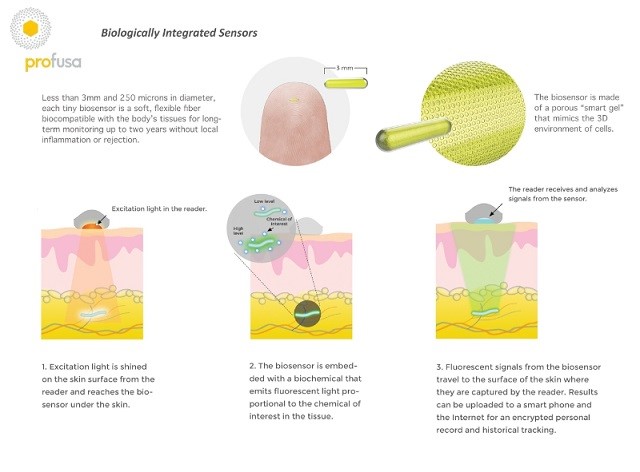The tissue-integrated sensors that were unveiled by Profusa at CES mark a premiere, as they are the first to track body chemistry continuously for long periods of time.
Profusa, a leader in the development of a new generation of biologically integrated sensors, has realized that keeping body chemistry in check could facilitate health and disease monitoring. The bioengineered biosensors that the company showcased at CES pave the way for real-time detection of the body chemistry for up to two years at a time, so that people and healthcare providers have access to medical-grade data.

“In between annual physicals we really don’t know what’s going on in our body,” explained Ben Hwang, Ph.D., Profusa’s CEO. “While fitness trackers and other wearables provide insights into our heart rate, respiration and other physical measures, they don’t provide information on the most important aspect of our health: our body’s chemistry. What if there was a better way of knowing how you’re doing — how you’re really doing?”
Some of the chronic health conditions such biosensors could prove useful for include Peripheral Artery Disease (PAD), diabetes, and Chronic Obstructive Pulmonary Disease (COPD). Dr. Hwang added: “Aimed at being a leading force in the digital disruption of medicine, Profusa’s real-time biosensors are poised to revolutionize healthcare, yielding significantly more insights into one’s overall health status and performance than tracking physical parameters alone.”
Most companies that develop and manufacturer devices that track various parameters of our bodies are mainly interested in helping us stay fit, but Profusa focuses on diabetes and other chronic diseases that have an impact on more than 70 million people just in the US.
The sensors, which look like a minuscule fiber that’s 3-5 mm long and about 500 microns in diameter, are placed under the skin using an injector that specifically designed for this. Profusa’s sensors don’t include any metal components or electronics, which helps them getting fully integrated within the body’s tissues without causing a foreign body response for up to two years.
The bioengineered “smart hydrogel” that the biosensors are made of resemble contact lens material. Capillaries and cells from the surrounding tissue start growing around the gel, which in turn is linked to a light-emitting molecule that triggers continuous signals when detecting biomarkers such as oxygen or glucose. A special optical reader is used for making sense of the fluorescent signals emitted by the embedded sensor.
Lumee Oxygen Sensing System, Profusa’s first medical device, is the only long-term tracking technology that measures tissue oxygen levels and makes sure that they remain within optimal limits during the wound treatment and healing process. Such a sensor is particularly useful in the treatment of chronic wounds from diabetic ulcers, reconstructive surgery and pressure sores. Given that some of these take up to one year to heal, if ever, and knowing just how important of a role oxygen plays in this process, making sure that low oxygen levels are prevented is extremely important.
“When low tissue oxygen is detected early, more treatment options can be considered, and the need for catastrophic amputation can be avoided,” concluded Christopher Owens, MD, MSc, Chief, Section of Vascular Surgery, Assoc. Prof. Surgery, San Francisco Veterans Medical Center, University of California, San Francisco.
Be social! Follow Walyou on Facebook and Twitter, and read more related stories about Novartis and Google’s smart contact lens, or the electronic tattoo that takes dermal temperature to a tenth of a degree.










